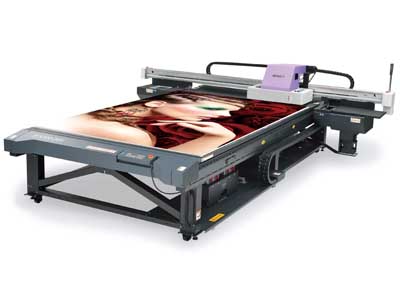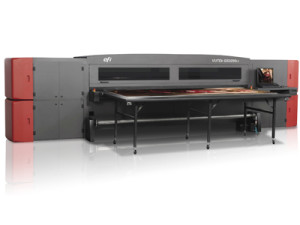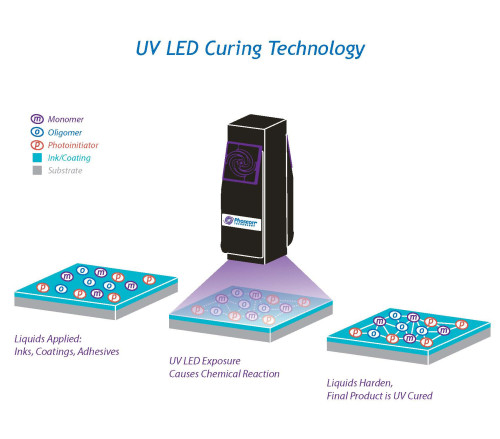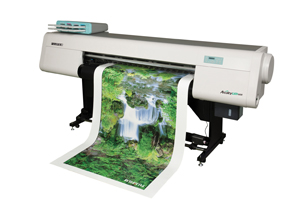Wide-format Graphics: The advantages of UV-LED curing
by all | 30 October 2014 10:36 am
 [1]By Ed Kiyoi
[1]By Ed Kiyoi
The wide-format printing sector is familiar by now with ultraviolet (UV) curing, which has allowed compatible inks to be instantly polymerized during the printing process, rather than rely on more traditional solvent-based inks, which must be allowed to dry and off-gas after printing. More recently, however, another game-changer for specialty graphic applications has been the use of light-emitting diodes (LEDs) for UV curing, instead of arc lamps.
LEDs open new possibilities for UV curing, including the printing of thinner and heat-sensitive materials, as LEDs run cooler than arc lamps. They can also be integrated into slimmer, more compact machines, will last longer with less need for maintenance and will save electrical costs through their greater energy efficiency. Further, LEDs contain no hazardous mercury or ozone and they emit UV light within a safer wavelength range than arc lamps do.
For LEDs to compete with arc lamps in the wide-format printing sector, of course, they have had to progress to the point where they can cure inks just as effectively, with a reliable breadth of UV light. The irradiance output of LEDs has certainly increased significantly over time, but more relevant to UV curing have been the design innovations in LED arrays, optics and thermal management that have enabled an increase in total UV output.
LEDs are semiconductors. Like most electronics in general, they need to be kept cool to ensure their reliability, performance and lifespan, so the design of the UV curing system must account for thermal management.

In 2011, EFI integrated UV LEDs in its Vutek GS3250LX printer. Fogra assessments showed the machine reduces engery use by up to 82 per cent compared to printers using conventional mercy arc UV lamps.
It has helped that wide-format printer manufacturers have worked closely with ink formulators to optimize UV LED curing. No longer merely an ‘emerging’ technology, there have been multiple successful deployments over the years, with a myriad of benefits.
Indeed, there is widespread adoption today of UV LEDs compared to just a few years ago, with ink formulators, printer manufacturers and print service providers (PSPs) working together to advance the technology.
Formulating inks
Advances in UV-curable ink formulations have also helped make UV LEDs a viable alternative to medium-pressure mercury lamps.
UV light triggers photoinitiators in inks to create ‘free radicals,’ which connect with molecules in resins and monomers to form cross-linked chains of molecules that comprise a cured ink film (see Figure 1). For the inks to cure properly, they must be exposed to a sufficient amount of energy in the correct wavelength ranges. This amount of energy is called the ‘dose’ and is measured in millijoules per square centimetre (mJ/cm2). The dose is affected by the printer’s conveyor or belt speed and the number of times the ink is exposed to the UV LEDs.
Until recently, UV-curable screenprinting inks did not offer sufficient processing latitude for compatibility with the relatively low wattage and narrow wavelength ranges of UV LEDs. Today, however, companies like Nazdar have adopted new technologies and developed screen inks that can be cured by LEDs to create graphics. The curing speed range is directly related to the colour of the ink and the substrate, as well as the ink deposit level.
As mentioned, UV LEDs also offer an opportunity for safer and more environmentally friendly printing. Inks developed for GCC’s StellarJet large-format printer, for example, are not only free of hazardous volatile organic compounds (VOCs), but also use special chemicals to eliminate potential irritants to machine-operating personnel.
Manufacturing printers
In 2008, Roland DGA’s VersaUV LEC series was reportedly the world’s first line of UV-curing inkjet printer/cutters to use low-heat LED lamps that would last up to 10,000 hours and enable printing on heat-sensitive media like paper stocks and shrink wrap.
“We’ve printed everything from small candy pouches on foils to point-of-purchase (POP) displays on solid bleached sulfate (SBS) board, all with great results,” says Rob Torres, director of digital media for White Graphics in Downers Grove, Ill.
In 2011, Electronics for Imaging (EFI) integrated UV LEDs in its 3.2-m (10.5-ft) wide Vutek GS3250LX digital inkjet printer to enable output on a wider media mix and for an extended range of applications, with less warping than with traditional UV curing, and at a low total cost of ownership (TCO).
 “UV LED lamps provide unique capabilities we could not have delivered to our customers with traditional mercury-based lamps,” said Ken Hanulec, EFI’s vice-president (VP) of marketing for inkjet systems.
“UV LED lamps provide unique capabilities we could not have delivered to our customers with traditional mercury-based lamps,” said Ken Hanulec, EFI’s vice-president (VP) of marketing for inkjet systems.
Energy assessments carried out by Fogra, a graphic technology research association, have found EFI’s Vutek printers with UV LEDs reduce energy use by up to 82 per cent when compared to printers using conventional mercury arc lamps. Even in print-ready mode, for example, the LEDs save up to 77 per cent in electricity use because they are turned off when the machine is idle between jobs, where mercury arc lamps would continue to consume power.
Durst Phototechnik introduced UV LEDs with its Omega 2 inkjet flatbed and roll-to-roll (R2R) printer, designed to allow graphic designers, signmakers and photo labs to print on a broader range of materials, including rigid aluminum composites, wooden panels, acrylics, polyvinyl chloride (PVC), paper, fabrics, polycarbonates and metals.
Mimaki developed new inkjet printheads, inks and UV LEDs for its JFX500-2131 grand-format printer in 2012. In addition to reducing power consumption compared to arc lamps, the LEDs were optimized to ensure no ink would be left uncured.
Fujifilm North America’s graphic systems division also adopted the technology in 2012 for the Acuity LED 1600 UV inkjet printer, engineering a patented full LED lamp system specifically to cure its Uvijet inks in a two-stage process. Small, low-dose LED ‘pinning’ lamps close to the printhead hold an ink drop in place while the main lamps fully cure the print. Adjustable lamp positioning also enables curing to be finely controlled.
In 2013, Barberán in Barcelona, Spain, introduced the Jetmaster-1260, a digital inkjet printer with UV LED curing designed for the single-pass printing of boards. Thanks to the LEDs’ compatibility with heat-sensitive substrates, the Jetmaster prints simulated wood grain texture patterns on a wide variety of materials, including cardboard, melamine, paper, particle board, medium-density fibreboard (MDF), high-density fibreboard (HDF) and texture-free wood. Printed at more than 1,400 dots per inch (dpi), the resulting ‘graphics’ feel like real wood grain to the touch. Applications of the technology include interior décor, foil-based wraps, decoration and architectural finishes.

Fujifilm North America’s graphic systems division engineered a patented full LED lamp system specifically to cure its Uvijet inks in the Acuity LED 1600 printer.
Printing specialty items
PVS In-store Graphics has used the Vutek GS3250LX to open new business opportunities by printing on uncommon substrates. The machine allowed the company to cure thinner materials without curling.
“Now we can roll up output for shipping instead of using flat boxes, saving the customer about 30 per cent on both the cost of materials and shipping,” explains Nick Olson, owner. “In addition, we’re very excited about the ability to print on new materials like aluminum, steel, wood and artists’ cotton canvas, which will certainly be a growth engine for our business.”
Meanwhile, Serigraphie Richford in Pointe-Claire, Que., has used applied ceramic labelling (ACL) technology with UV LED curing to screenprint graphics directly onto glass containers for health and beauty products, spirits, beer, wine, cider, soft drinks and water, along with promotional glassware. Not only ink, but also enamels, precious metals and other specialty materials can be applied.
The company has more than 30 years’ experience printing and decorating glass containers for clients like Estée Lauder, Avon, Revlon, L’Oréal, Diageo, Pernod-Ricard, Vincor and Sleeman, but reports UV LED curing technology has improved the quality of its work, even when processing materials at maximum production speeds.
These are just a few examples of how PSPs are using printers with UV LEDs to improve their existing product lines and expand into new applications. This trend will only continue as new wide-format printers are engineered with LEDs for reliable, high-performance curing.
Ed Kiyoi is technical marketing engineer for Phoseon Technology, which develops UV LED lamps for the curing of inks, coatings and adhesives. This article is based on a webinar he presented earlier this year on behalf of the Specialty Graphic Imaging Association (SGIA). For more information, visit www.phoseon.com[2] and www.sgia.org[3].
- [Image]: http://www.signmedia.ca/wp-content/uploads/2014/10/crop11.jpg
- www.phoseon.com: http://www.phoseon.com
- www.sgia.org: http://www.sgia.org
Source URL: https://www.signmedia.ca/wide-format-graphics-the-advantages-of-uv-led-curing/